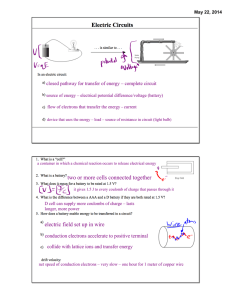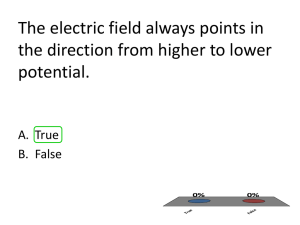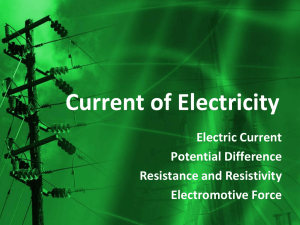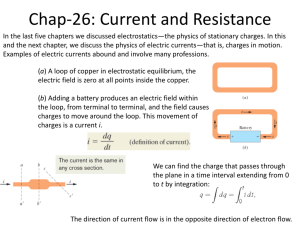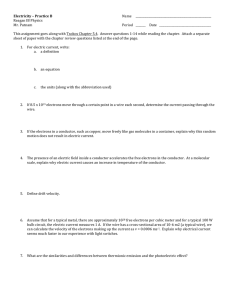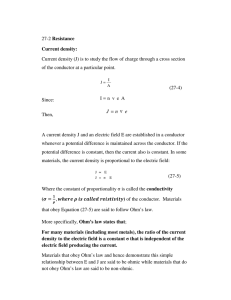AV - UCSDTier2
advertisement
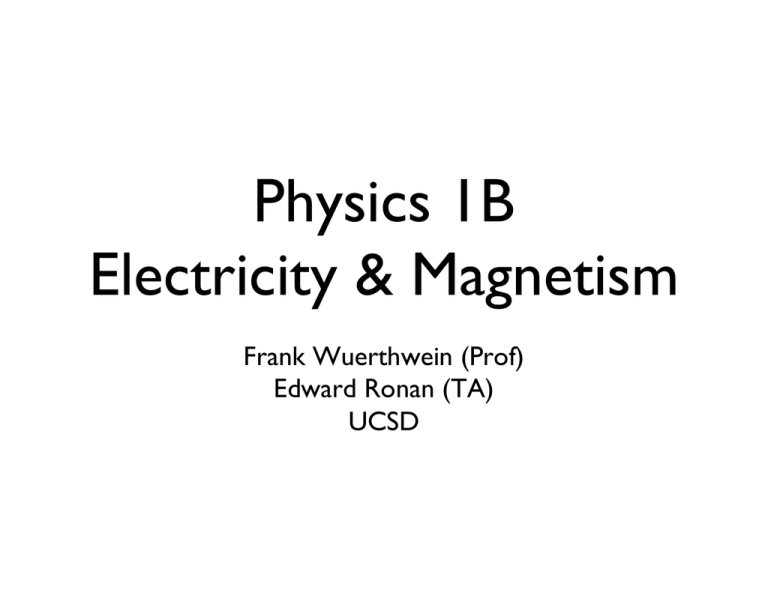
Physics 1B Electricity & Magnetism Frank Wuerthwein (Prof) Edward Ronan (TA) UCSD Quiz 1 • Quiz 1A and it’s answer key is online at course web site. • http://hepuser.ucsd.edu/twiki2/bin/view/ UCSDTier2/Physics1BWinter2012 • Grades are now online Outline of today • Finish Chapter 20. • Energy of a Capacitor • Beginning of Chapter 21 Energy of a Capacitor • The energy stored in a capacitor will be: " The main use of a capacitor is to store and then discharge energy. • Example Capacitance • A 3.55μF capacitor (C ) is charged to a potential difference 1 ΔVo = 6.30 V, using a battery. the charging battery is then removed, and the capacitor is connected to an uncharged 8.95μF capacitor (C2). After the switch is closed, charge flows from C1 to C2 until an equilibrium is established with both capacitors at the same potential difference, ΔVf. What energy is stored in the two capacitors after the switch has been closed? " " Answer Usually no coordinate system needs to be defined for a capacitor (start with the original charge amount Qo.) Capacitance Answer The original charge, Qo, shared by the two capacitors is: " " Qo = Q1 + Q2 " Next, turn to the definition of capacitance: " Substituting back into our charge equation gives us: " ! C1 ("Vo ) = C1 ("V1 ) + C2 ("V2 ) But we know the final potential difference is the same between the two capacitors: "V1 = "V2 = "V f ! C1 ("Vo ) = C1 ("V f ) + C2 ("V f ) = (C1 + C2 )"V f Capacitance Answer Solving for ΔVf gives us: " " 3.55µF(6.30V) "V f = = 1.79V ( 3.55µF + 8.95µF) C1 ("Vo ) "V f = (C1 + C2 ) " Putting this common potential difference into the energy equation gives us: E Tot = E1 + E 2 ! 2 1 2 1 2 E Tot = C1 ("V f ) + C2 ("V f ) E Tot = ! ! E Tot = 1 2 1 2 (C1 + C2 )("V f ) 2 2 (3.55µF + 8.95µF)(1.79V) 2 = 20.0µJ Chapter 21 Current and Circuits Current • Up until now, we have dealt with electrostatics (i.e. charges that do not move). • We now define electric current, I, to be the rate at which electric charge passes through a surface or volume. " The SI unit for current is the Ampere. Current • What causes electric current to flow? • An electric potential difference, usually created by some sort of battery. The battery uses chemical energy to create ΔV. • Current is defined as positive charges moving in a certain direction. + " I + + If negative charges are actually moving, then current is defined as moving opposite to the motion of the negative charges. I – – – Current • What physically flows through wires: positive charges or negative charges? • It is the tiny electrons that move in the wire. They move more easily than the massive protons. • But due to historical reasons, we use positive current when performing calculations. • How fast do electrons move in a wire under current flow? • Not fast at all, electrons move about 0.5mm/s in a conducting wire. Current Current • If electrons move so slowly, then why do lights turn on exactly when I hit the switch? • The electron at the switch isn t the one that will give energy to the lights. • When you turn on a light switch you are establishing an electric field that moves all the free electrons in the wire circuit. • It’s the E field that is established fast, while the electrons move slow. • You need a closed loop with the wire. An open loop means no electric field and no current flow. This is known as an open circuit. " " Current • When a battery is placed in a closed loop an electric field is established inside the conducting wire. • This electric field starts on the positive terminal and ends on the negative terminal. Positive charges will move with the electric field toward the negative terminal. When the circuit is open, the positive charges don t see a negative terminal and thus, no current. Current • The potential difference created by the battery terminal is also called EMF (ElectroMotive Force). • This is a silly name as EMF is measured in Volts. • We physically measure the amount of current in a circuit with an ammeter. " You connect the ammeter in the circuit in series with the element you are trying to measure the current of. Current • A voltmeter is used to measure electric potential difference (or voltage). • You connect a voltmeter in the circuit in parallel to the element you are trying to measure the potential difference of. " You basically want to measure what the potential was before the element and what the potential is after the element. Ohm s Law • No matter how good your conductor is, you are always going to have a minute slowing of current due to the conductor. • Ohm s Law quantifies the ability of a given material to resist the flow of charge for a given electric potential difference. ΔV = I R " " where R is called the resistance and is measured in Ω (Ohm s). [Ω] = [Volt]/[Ampere] Ohm s Law • A good conductor will have a low resistance, this means that current will easily flow through it. • A good insulator will have a high resistance, this means that current will have a very hard time flowing through it. • With Ohm s Law, as you increase electric potential (ΔV), then current will increase linearly. • The resistance in a circuit arises due to collisions between the electrons moving against the electric field and the electrons that are fixed in the atoms. Ohm s Law • Ohm s Law is not really a law in the technical sense. merely defines the resistance for certain materials. • Certain materials obey Ohm s Law, these are called " " ohmic materials. There is a linear relationship between current and electric potential. Certain materials do not obey Ohm s Law, these are called nonohmic materials. It Resistivity • If I were constructing a wire, for a given battery how could I lower its resistance? • Use a good conductor. • Increase its cross-sectional area. • Shorten its length. " The resistance of an ohmic conductor is given by: ρ is called resistivity (depends on the type of material of the conductor). " L is the length of the conductor and A is the crosssectional area of the conductor. " Resistivity • Resistivity is measured in units of: [Ω m] • For most metals, as you increase the temperature the resistivity of the metal increases. • Thus, a higher temperature leads to a greater resistance. • The atoms in the metal are vibrating more than at a lower temperature; making it more difficult for electrons to pass through without being slowed. Resistivity • The following equation takes temperature into account for resistivity: " where ρ is the resistivity at some temperature T. " ρo is the resistivity at some reference temperature To. " α is the temperature coefficient of resistivity. " To is usually taken to be 20oC. " " " Concept Question • Two wires of equal length and identical metals but different diameters are connected to identical batteries (ΔVfat = ΔVskinny). What can we say about the resulting currents? A) The current in the fat wire is greater. ΔVskinny skinny wire ΔVfat fat wire B) The current in the skinny wire is greater. C) The currents in both wires are exactly the same. For Next Time (FNT) • Start homework for Chapter 21 • Continue reading Chapter 21
